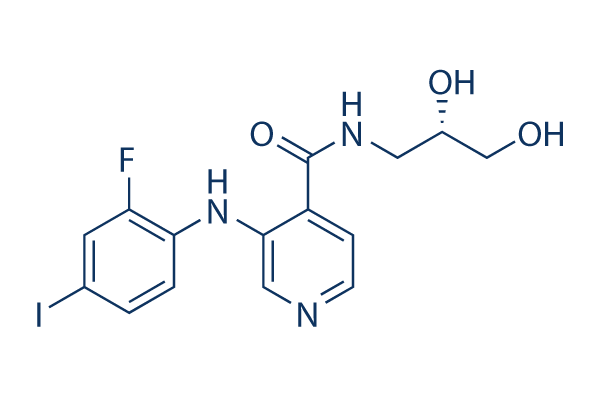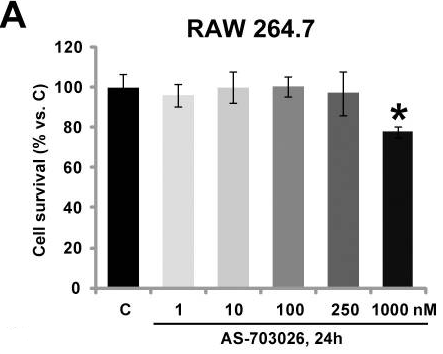
- Inhibitors
- By product type
- Natural Products
- Inducing Agents
- Peptides
- Antibiotics
- Antibody-drug Conjugates(ADC)
- PROTAC
- Hydrotropic Agents
- Dyes
- By Signaling Pathways
- PI3K/Akt/mTOR
- Epigenetics
- Methylation
- Immunology & Inflammation
- Protein Tyrosine Kinase
- Angiogenesis
- Apoptosis
- Autophagy
By research - Antibodies
- Compound Libraries
- Popular Compound Libraries
- Customize Library
- Clinical and FDA-approved Related
- Bioactive Compound Libraries
- Inhibitor Related
- Natural Product Related
- Metabolism Related
- Cell Death Related
- By Signaling Pathway
- By Disease
- Anti-infection and Antiviral Related
- Neuronal and Immunology Related
- Fragment and Covalent Related
- FDA-approved Drug Library
- FDA-approved & Passed Phase I Drug Library
- Preclinical/Clinical Compound Library
- Bioactive Compound Library-I
- Bioactive Compound Library-Ⅱ
- Kinase Inhibitor Library
- Express-Pick Library
- Natural Product Library
- Human Endogenous Metabolite Compound Library
- Alkaloid Compound LibraryNew
- Angiogenesis Related compound Library
- Anti-Aging Compound Library
- Anti-alzheimer Disease Compound Library
- Antibiotics compound Library
- Anti-cancer Compound Library
- Anti-cancer Compound Library-Ⅱ
- Anti-cancer Metabolism Compound Library
- Anti-Cardiovascular Disease Compound Library
- Anti-diabetic Compound Library
- Anti-infection Compound Library
- Antioxidant Compound Library
- Anti-parasitic Compound Library
- Antiviral Compound Library
- Apoptosis Compound Library
- Autophagy Compound Library
- Calcium Channel Blocker LibraryNew
- Cambridge Cancer Compound Library
- Carbohydrate Metabolism Compound LibraryNew
- Cell Cycle compound library
- CNS-Penetrant Compound Library
- Covalent Inhibitor Library
- Cytokine Inhibitor LibraryNew
- Cytoskeletal Signaling Pathway Compound Library
- DNA Damage/DNA Repair compound Library
- Drug-like Compound Library
- Endoplasmic Reticulum Stress Compound Library
- Epigenetics Compound Library
- Exosome Secretion Related Compound LibraryNew
- FDA-approved Anticancer Drug LibraryNew
- Ferroptosis Compound Library
- Flavonoid Compound Library
- Fragment Library
- Glutamine Metabolism Compound Library
- Glycolysis Compound Library
- GPCR Compound Library
- Gut Microbial Metabolite Library
- HIF-1 Signaling Pathway Compound Library
- Highly Selective Inhibitor Library
- Histone modification compound library
- HTS Library for Drug Discovery
- Human Hormone Related Compound LibraryNew
- Human Transcription Factor Compound LibraryNew
- Immunology/Inflammation Compound Library
- Inhibitor Library
- Ion Channel Ligand Library
- JAK/STAT compound library
- Lipid Metabolism Compound LibraryNew
- Macrocyclic Compound Library
- MAPK Inhibitor Library
- Medicine Food Homology Compound Library
- Metabolism Compound Library
- Methylation Compound Library
- Mouse Metabolite Compound LibraryNew
- Natural Organic Compound Library
- Neuronal Signaling Compound Library
- NF-κB Signaling Compound Library
- Nucleoside Analogue Library
- Obesity Compound Library
- Oxidative Stress Compound LibraryNew
- Plant Extract Library
- Phenotypic Screening Library
- PI3K/Akt Inhibitor Library
- Protease Inhibitor Library
- Protein-protein Interaction Inhibitor Library
- Pyroptosis Compound Library
- Small Molecule Immuno-Oncology Compound Library
- Mitochondria-Targeted Compound LibraryNew
- Stem Cell Differentiation Compound LibraryNew
- Stem Cell Signaling Compound Library
- Natural Phenol Compound LibraryNew
- Natural Terpenoid Compound LibraryNew
- TGF-beta/Smad compound library
- Traditional Chinese Medicine Library
- Tyrosine Kinase Inhibitor Library
- Ubiquitination Compound Library
-
Cherry Picking
You can personalize your library with chemicals from within Selleck's inventory. Build the right library for your research endeavors by choosing from compounds in all of our available libraries.
Please contact us at info@selleckchem.com to customize your library.
You could select:
- Bioreagents
- qPCR
- 2x SYBR Green qPCR Master Mix
- 2x SYBR Green qPCR Master Mix(Low ROX)
- 2x SYBR Green qPCR Master Mix(High ROX)
- Protein Assay
- Protein A/G Magnetic Beads for IP
- Anti-Flag magnetic beads
- Anti-Flag Affinity Gel
- Anti-Myc magnetic beads
- Anti-HA magnetic beads
- Poly DYKDDDDK Tag Peptide lyophilized powder
- Protease Inhibitor Cocktail
- Protease Inhibitor Cocktail (EDTA-Free, 100X in DMSO)
- Phosphatase Inhibitor Cocktail (2 Tubes, 100X)
- Cell Biology
- Cell Counting Kit-8 (CCK-8)
- Animal Experiment
- Mouse Direct PCR Kit (For Genotyping)
- Featured Products
- MRTX1133
- Nab-Paclitaxel
- KP-457
- IAG933
- RMC-6236 (Daraxonrasib)
- RMC-7977
- Zoldonrasib (RMC-9805)
- GsMTx4
- Navitoclax (ABT-263)
- TSA (Trichostatin A)
- Y-27632 Dihydrochloride
- SB431542
- SB202190
- MK-2206 Dihydrochloride
- LY294002
- Alisertib (MLN8237)
- XAV-939
- CHIR-99021 (Laduviglusib)
- Bafilomycin A1 (Baf-A1)
- Thiazovivin (TZV)
- CP-673451
- Verteporfin
- DAPT
- Galunisertib (LY2157299)
- MG132
- SBE-β-CD
- Tween 80
- Bavdegalutamide (ARV-110)
- Z-VAD-FMK
- Wnt-C59 (C59)
- IWR-1-endo
- (+)-JQ1
- 3-Deazaneplanocin A (DZNep) Hydrochloride
- RepSox (E-616452)
- Erastin
- Q-VD-Oph
- Puromycin Dihydrochloride
- Cycloheximide
- Telaglenastat (CB-839)
- A-83-01
- Ceralasertib (AZD6738)
- Liproxstatin-1
- Emricasan (IDN-6556)
- PMA (Phorbol 12-myristate 13-acetate)
- Dibutyryl cAMP (Bucladesine) sodium
- Nedisertib (M3814)
- PLX5622
- IKE (Imidazole Ketone Erastin)
- STM2457
- Saruparib (AZD5305)
- New Products
- Contact Us
research use only
Pimasertib (AS-703026) MEK inhibitor
Cat.No.S1475

Chemical Structure
Molecular Weight: 431.20
Quality Control
Batch:
Purity:
99.93%
99.93
| Related Targets | Ras ERK p38 MAPK Raf JNK S6 Kinase MAP4K TAK1 Mixed Lineage Kinase ASK MNK MAPKAPK2 KLF TOPK | |
|---|---|---|
| Related Products | Mirdametinib (PD0325901) U0126-EtOH PD98059 PD184352 (CI-1040) BIX 02189 Refametinib (RDEA119) TAK-733 AZD8330 BIX 02188 GDC-0623 SL-327 Myricetin BI-847325 PD318088 APS-2-79 HCl |
Cell Culture, Treatment & Working Concentration
| Cell Lines | Assay Type | Concentration | Incubation Time | Formulation | Activity Description | PMID |
|---|---|---|---|---|---|---|
| human COLO205 cells | Function assay | Inhibition of MEK1 in human COLO205 cells, IC50=0.00181 μM | ||||
| Click to View More Cell Line Experimental Data | ||||||
Chemical Information, Storage & Stability
| Molecular Weight | 431.20 | Formula | C15H15FIN3O3 |
Storage (From the date of receipt) | |
|---|---|---|---|---|---|
| CAS No. | 1236699-92-5 | Download SDF | Storage of Stock Solutions |
|
|
| Synonyms | MSC1936369B, SAR 245509 | Smiles | C1=CC(=C(C=C1I)F)NC2=C(C=CN=C2)C(=O)NCC(CO)O | ||
Solubility
|
In vitro |
DMSO : 86 mg/mL ( (199.44 mM) Moisture-absorbing DMSO reduces solubility. Please use fresh DMSO.) Water : Insoluble Ethanol : Insoluble |
Molarity Calculator
|
In vivo |
|||||
In vivo Formulation Calculator (Clear solution)
Step 1: Enter information below (Recommended: An additional animal making an allowance for loss during the experiment)
mg/kg
g
μL
Step 2: Enter the in vivo formulation (This is only the calculator, not formulation. Please contact us first if there is no in vivo formulation at the solubility Section.)
% DMSO
%
% Tween 80
% ddH2O
%DMSO
%
Calculation results:
Working concentration: mg/ml;
Method for preparing DMSO master liquid: mg drug pre-dissolved in μL DMSO ( Master liquid concentration mg/mL, Please contact us first if the concentration exceeds the DMSO solubility of the batch of drug. )
Method for preparing in vivo formulation: Take μL DMSO master liquid, next addμL PEG300, mix and clarify, next addμL Tween 80, mix and clarify, next add μL ddH2O, mix and clarify.
Method for preparing in vivo formulation: Take μL DMSO master liquid, next add μL Corn oil, mix and clarify.
Note: 1. Please make sure the liquid is clear before adding the next solvent.
2. Be sure to add the solvent(s) in order. You must ensure that the solution obtained, in the previous addition, is a clear solution before proceeding to add the next solvent. Physical methods such
as vortex, ultrasound or hot water bath can be used to aid dissolving.
Mechanism of Action
| Features |
A novel, highly selective and potent allosteric inhibitor of MEK1/2.
|
|---|---|
| Targets/IC50/Ki |
MEK1/2 (MM cell line) [1]
(Cell-free assay) 5 nM-2 μM
|
| In vitro |
AS703026 is a novel, selective, orally bioavailable MEK1/2 inhibitor that binds to the distinctive MEK allosteric site and therefore exhibits exquisite kinase selectivity. AS703026 inhibits growth and survival of human multiple myeloma (MM) cells, including U266 and INA-6, with IC50 of 5 nM and 11 nM, respectively. Such an inhibitory effect by AS703026 is mediated by G0-G1 cell cycle arrest and is accompanied by reduced expresson of the MAF oncogene. AS703026 further induces apoptosis via caspase-3 and PARP cleavage in MM cells, both in the presence or absence of bone marrow stromal cells (BMSCs). [1]
AS703026 may be an effective therapy in colorectal cancer caused by K-Ras mutation. AS703026 (10 μM) effectively inhibits the ERK pathway, proliferation, and transformation in human DLD-1 colorectal cancer cells what carry a mutant allele of K-Ras (D-MUT). [2]
|
| Kinase Assay |
MEK1 enzyme assays
|
|
AS703026 is dissolved in 2.5% DMSO. Activated diphosphorylated MEK (pp-MEK) assays contained 40 μM 33P-γATP (AppKm 8.5 μM), 0.5 nM human-activated MEK1 or MEK2, 1 μM kinase-dead ERK2 (AppKm 0.73 μM). All assays are done in buffer containing 20 mM HEPES (pH 7.2), 5 mM 2-mercaptoethanol, 0.15 mg/mL BSA, and 10 mM MgCl2. The final concentration of 33P- ATP is 0.02 μCi/μL for all the assays. pp-MEK kinase reactions are stopped after 40 min by transferring 30 μL of reaction mixture to Durapore 0.45-μm filters plates containing 12.5% TCA. Filters are dried and read with liquid scintilant on a TopCount. Concentration response data are analyzed for IC50. 0.2 nM recombinant human MEK1 or MEK2 is preincubated with vehicle or with AS703026 for 40 minutes in reaction buffer to determine IC50 of initially unphosphorylated MEK (u-MEK). Phosphorylation/activation is initiated by the addition of a final concentration of 20 nM final B-RafV600E and 30 μM final ATP for 10 min. B-Raf activity is then quenched by addition of the B-Raf inhibitor SB590885 (final concentration 100 nM), and MEK kinase activity is assayed by the addition of 1 μM KD-ERK2 and 0.02 μCi/μL 33P-ATP in reaction buffer. The kinase reactions are stopped after 90 min by transferring 30μL of reaction mixture to a Durapore filter plate, and read as above.
|
|
| In vivo |
AS703026 (15 and 30 mg/kg) significantly inhibits tumor growth in a human plasmacytoma xenograft model of H929 MM cells. This can be correlated with downregulated pERK1/2, induced PARP cleavage, and decreased microvessels. [1]
AS703026 (10 mg/kg) inhibits tumor growth, and markedly decreases p-ERK level in a xenograft mouse model of human K-Ras mutated (D-MUT) colorectal tumor. [2]
|
References |
Applications
| Methods | Biomarkers | Images | PMID |
|---|---|---|---|
| Western blot | p-ERK / ERK |

|
27102436 |
| Growth inhibition assay | Cell viability |

|
26381508 |
Clinical Trial Information
(data from https://clinicaltrials.gov, updated on 2024-05-22)
| NCT Number | Recruitment | Conditions | Sponsor/Collaborators | Start Date | Phases |
|---|---|---|---|---|---|
| NCT01985191 | Completed | Neoplasm Malignant |
Sanofi|Merck KGaA Darmstadt Germany |
November 2013 | Phase 1 |
| NCT01713036 | Completed | Locally Advanced or Metastatic Solid Tumors |
Merck KGaA Darmstadt Germany |
November 30 2012 | Phase 1 |
| NCT01668017 | Terminated | Advanced Solid Tumors|Hepatocellular Carcinoma |
Merck KGaA Darmstadt Germany|Merck Serono Co. Ltd. Japan |
September 30 2012 | Phase 1 |
| NCT01378377 | Terminated | Advanced Solid Tumor |
EMD Serono |
May 27 2011 | Phase 1 |
Tech Support
Tel: +1-832-582-8158 Ext:3
If you have any other enquiries, please leave a message.






































